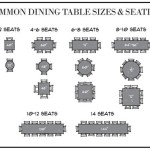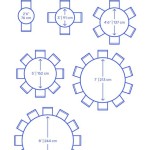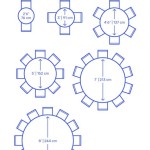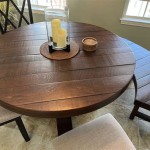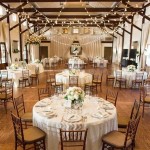How To Decorate a Round Table With a Runner
Round tables present unique decorating challenges and opportunities. Their circular shape creates a natural focal point, encouraging conversation and a sense of unity. A table runner, while seemingly simple, plays a significant role in enhancing this inherent quality. It anchors the tablescape, adds visual interest, and provides a foundation for other decorative elements.
Choosing the right runner size is crucial. For a round table, the runner should drape gracefully without overwhelming the surface. It should extend far enough down the sides to create visual flow but not so long that it interferes with seating. A general guideline is for the runner to hang down approximately 10-12 inches on each side. However, this can be adjusted based on personal preference and the overall table size.
The runner's material and texture contribute significantly to the overall aesthetic. For a formal setting, materials like silk, satin, or high-quality linen offer elegance. For a casual or rustic look, burlap, cotton, or even a textured woven material work well. Consider the existing décor of the room and the occasion when selecting the runner's material and texture.
Color plays a pivotal role in setting the mood and tying the table décor together. A neutral-colored runner provides a versatile backdrop for more vibrant centerpieces and place settings. Bold colors can make a statement and create a focal point. Consider using a runner in a color that complements or contrasts with the tablecloth or the surrounding room décor.
Positioning the runner is key to achieving a balanced and visually appealing tablescape. The most common placement is to center the runner directly down the middle of the table. This creates a classic and symmetrical look. Alternatively, the runner can be positioned slightly off-center for a more relaxed and asymmetrical feel. Experiment with different placements to find what works best for the specific table and décor.
Once the runner is in place, layering other decorative elements enhances the overall design. A centerpiece is a natural focal point and can be placed directly on top of the runner. The centerpiece can be a floral arrangement, a collection of candles, a decorative bowl, or any other item that complements the overall theme.
Placemats and chargers add another layer of texture and visual interest. These should be positioned around the edge of the table, with the runner flowing between them. Choose placemats and chargers that complement the runner's color and material. They can either blend seamlessly or provide a subtle contrast.
Adding candles to the tablescape creates ambiance and warmth. Candlesticks can be placed directly on the runner, either flanking the centerpiece or arranged in a visually appealing grouping. Votive candles in decorative holders can also be scattered along the runner for a more intimate feel.
Floral arrangements are a classic way to add life and color to a table setting. A centerpiece on the runner can be a focal point, while smaller floral arrangements or individual stems can be placed along the runner to enhance the overall design. The choice of flowers should complement the runner's color and the overall theme of the event.
Seasonal decorations offer an opportunity to personalize the table setting. For autumn, consider adding pumpkins, gourds, or fall leaves to the runner. For winter, pine cones, evergreen branches, and ornaments create a festive touch. Spring calls for fresh flowers and pastel colors, while summer lends itself to bright colors and natural elements like seashells or driftwood.
The use of decorative objects adds personality and a unique touch to the tablescape. Small sculptures, decorative bowls, or even antique items can be placed on the runner, either as part of the centerpiece or as individual accents. These objects can reflect personal interests or hobbies and add a touch of whimsy to the table setting.
Layering different textures adds depth and visual interest to the tablescape. Consider combining a smooth linen runner with textured placemats or incorporating natural elements like wood or stone. The interplay of different textures creates a more dynamic and engaging visual experience.
The symmetry and asymmetry play a role in the overall balance of the table setting. A symmetrical arrangement, with the runner centered and the centerpiece flanked by identical elements, creates a formal and traditional look. An asymmetrical arrangement, with the runner slightly off-center and varying decorative elements, creates a more relaxed and contemporary feel.
Consider the scale and proportion of the decorative elements when designing the tablescape. The size of the centerpiece, the height of the candlesticks, and the scale of other decorative objects should be proportionate to the size of the table and the runner. Avoid overcrowding the table with too many elements. A balanced and well-proportioned tablescape is more visually appealing.
The functionality of the tablescape should also be considered. While aesthetics are important, ensure the decorations do not interfere with the practical use of the table. Guests should be able to comfortably converse and dine without being obstructed by overly tall centerpieces or cluttered decorations.

Table Runners For Round Tables Decor Runner Kitchen Settings

Table Runners For Round Tables Find The Right Runner

Table Runners For Round Tables Find The Right Runner

31 Table Runner Ideas For Wedding Receptions 7 Will Steal Your Heart Designs Rehearsal Dinner Decorations Rustic

The Best Round Table Runner Ideas Arinsolangeathome Wedding Tables Runners Settings

Gorgeous Round Table Centerpiece Ideas For Summer Perfecting Places

33 Table Runner Ideas To Enhance Your Dining Experience

The Best Table Runner Ideas For A Round Dining Sonata Home Design

40 Round Wedding Table Decorations Ideas 2024 5 Tips Tables Runners Burlap

Stunning Fall Table Runner Ideas Life On Summerhill
Related Posts

